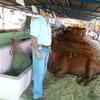Cruzamiento Brahman con Senepol
Publicado: 4 de mayo de 2005
Fuente: Ruben Hernandez
Hola, tengo un hato de ganado brahman puro y me interesaria hacer unos cruce con raza Senepol he consultado aqui en Panama sobre los resultado que se obtendrian pero no he encontrado una respuesta, que me podrian aconsejar de este cruce.
Temas relacionados:
Mencionados en esta noticia:
Recomendar
Comentar
Compartir
24 de diciembre de 2015
Amigos tengan ustedes un muy Feliz Navidad
En mi criterio el punto más importante en este criterio es el mejoramiento de la carne
Por supuesto una vez resuelto el tema de adaptación al trópico
Las cruzas Senepol x Brahman o Senepol x Simbrah han sido superiores en producir carne Calidad Choice y Select que las cruzas de Simbrah x Simbrah
Y superiores que Angus x Simbrah
Y ese es el punto medular
No tiene objeto un mejoramiento genético si no está obteniendo rentabilidad con ello.
Se debe tratar a toda costa de ya no vender ganado en pie, vendamos carne y no carne comercial sino carne prime, Choice o Select
Quiero destacar como genetista que el Senepol en su categoría como mejorador solo hay dos razas que le superan en la categoría de criollos, estos son:
A) El Wagyu Akaushi mismo que al cruzarlo con Brahman le producirá Cortés Prime y con grasa mucha grasa que hasta la grasa se vende por ser no dañina para la salud humana.
B) El Harton raza colombiana que posee una resistencia a la Leucosis, cosa que el Senepol no tiene. Así también es una raza lechera para los que están en el doble propósito. Yo tengo la ilusión de incorporar esta capacidad al Senepol realizando un Purebreed a base de Harton de los valles de Colombia. Espero cumplir este cometido antes de morir; y si en caso no lo logre que este foro sirva de memoria y que alguien de ustedes lo logre.
Simplemente estoy enamorado del Senepol es una raza magnífica
Recomendar
Responder
24 de diciembre de 2015
EN MUCHAS ZONAS GANADERAS DE NUESTROS PAISES TROPICALES , SE HAN ADAPTADO GANADO CRIOLLO POR GENERACIONES, SE HA SELECCIONADO GANADO CON CUALIDADES SUPERIORES COMO CALIDAD DE CARNE, PALATABILIDAD,CON MENOS FIBRA, ETC. Y POR LO TANTO SON POTENCIALMENTE FACTIBLES DE CRUZAR CON UNA RAZA COMO LA BRAHMAN CON CUALIDADES DEFINIDAS EN VELOCIDAD DE CRECIMIENTO,ADAPTACION AL TROPICO Y BUENAS CUALIDADES DE CALIDAD DE CARNE, Y SE ESPERA UN CRUZAMIENTO CON BUENOS RESULTADOS QUE RESALTARIAN LO MEJOR DE AMBAS RAZAS BOVINAS
Recomendar
Responder


Institut de Recerca I Tecnologia Agroalimentàries (IRTA)
La finalidad del IRTA es contribuir a la modernización, a la mejora y al impulso de la competitividad, al desarrollo sostenible de los sectores agrario, ali
Enlace recomendado
26 de diciembre de 2015
ESTIMADOS. Más allá de preferencias personales, no hay ninguna raza "mejor" universal, sino algunas mas convenientes por adaptadas y adecuadas a las circunstancias productivas y de mercado. De acuerdo con el Ing.Silva ( Perú) el "Criollo de las Américas" es una de ellas e indicada para la región como raza pura o cruzante (F1). Para el Sr.Hernández creo que la cruza Brahman x Criollo puede ser útil a condición de bien aplicada. En Argentina de los '60-´70 la introducción de Brahman y Nelore sobre el rodeo criollo existente fue un "boom" que se atribuyó a la raza índica cuando en realidad fue el efecto de la heterosis tipica de primera generación. El uso indiscriminado de estos cruzamientos terminó en el denominado "blanqueo del rodeo", con índices productivos y reproductivos peores que al comienzo. Aunque no son extrapolables, nuestros resultados demuestran la aptitud del Criollo Argentino en cruzamientos industriales, sin comprometer la capacidad de crecimiento , el rendimiento carnicero ni la calidad de carne, como los interesados podrán observar [¿Producir carne con la raza Criolla Argentina?- http://.producción-animal.com.ar/ Bovinos de Carne / Criolla Argentina]. De este trabajo como en otros similares, se deduce que la calidad de carne ( palatabilidad ) depende de muchos factores, entre ellos "el humano".Es difícil atribuir éstas características exclusivamente a determinada raza o cruza (genotipo ). No debiera ser un objetivo de la selección artificial para "carne", en animales que serán criados bajo nuestras condiciones de producción "a campo" y toda vez que no hay peor novillo que un ternero muerto. Lograr reses para otros mercados (select & choice ) puede confundir, aunque de acuerdo con el Ing. Contreras (Guatemala) , pero siempre y cuando dicha demanda y la relación costo/beneficio para satisfacerla estén aseguradas. Cordialmente. MV.Carlos A.Garriz
Recomendar
Responder


FIGAP - Exposición Internacional
FIGAP es la Exposición Mexicana de caracter Internacional vinculada a la industria de alimentos balanceados, salud, nutrición y genética en producción anima
Enlace recomendado
26 de diciembre de 2015
EL BRAHMAN Y NELOR NO PUEDEN HABER DADO UNA PRODUCCIÓN INFERIOR A LA QUE EXISTÍA EN EL NORTE, ARGENTINO, SUB TROPICAL. SI A ALGUNO LE FUE MAL HABRÁ SIDO POR PONER TOROS DE BAJA PRODUCTIVIDAD. SI USAMOS UN ANGUS, EN ZONA TEMPLADA, CON TESTÍCULOS CON CE DE 10 CM, PARADO DE GARRONES, LOCO, SIN ARCO DE COSTILLAS, TAMBIÉN DARÁ MALA PRODUCCIÓN. CADA ZONA TIENE SUS ANIMALES MAS ADECUADOS, Y CIRCUNSTANCIALMENTE PUEDE QUE POR DETERMINADOS AÑOS HAYA QUE USAR LA RAZA QUE SE DEBERÁ CAMBIAR EN EL FUTURO, HASTA CAMBIAR LO QUE IMPIDE CRIARLA DESDE EL PRIMER MOMENTO.
Recomendar
Responder
27 de diciembre de 2015
Estimados: Agradecido comparto los conceptos del colega Dr. Gonzalez. Por el contexto estimo responden a mi precedente participación. Aunque la circunstancia ya es histórica , la mención de "boom" indica el éxito del cruzamiento con dichas razas índicas, también observados en INTA Leales Tucumán RA, con cruzamientos (F1) entre Nelore y Criollo ("Cribu"). No desmerece a las razas mencionar "uso indiscriminado", que sólo significa "mala praxis" en la aplicación de cruzamientos y que posiblemente, de acuerdo y como bien dice el colega, con factores ambientales y de manejo inadecuados, resultaron en la disminución de la productividad a nivel general o "blanqueo del rodeo", que actualmente podría ser asimilado al concepto de efecto antropogenico o antrópico. Sobre que - " el Brahman y Nelore no pueden haber dado una producción inferior a la que existía en el norte argentino subtropical" - los estudios de INTA Leales relativizan tal afirmación. Las comparaciones de producción en cría entre Hereford, Criollo y Nelore (% de parición; % mortalidad predestete; peso de destete; peso de vaca; relación peso destete / peso de vaca y kg/ha/año) , muestran que, sin diferencias en % de parición (fertilidad), la performance en los restantes parámetros fue menor en Hereford (ambiente ) que en Criollo y Nelore, prácticamente iguales entre sí y ambos adaptados al norte argentino subtropical. Sin ser definitivos son suficientes para mostrar un Bos taurus propio (selección natural ) con por lo menos la misma capacidad de producción en cría que un Bos indicus importado ( selección artificial ). Profundizar en este resultado y en el interrogante que plantea excede la presente. [ El Bovino Criollo Argentino: Historia, características y productividad" - Florencio Sal Paz - Ganado Bovino Criollo Tomo I-II; pp 3-7 / Impresiones Amawald. Bs.As.RA ] .Cordialmente. Carlos A.Garriz
Recomendar
Responder


Priya Chemicals
Priya Chemicals es el mayor fabricante de aminoácidos y productos a base de aminoácidos para el uso en el ámbito de nutracéuticos, Agricultura y Veterinaria
Enlace recomendado
5 de diciembre de 2016
Amigos necesito de su consejo y experiencia tengo 30 hts. de tierra en San Martin meta y con un socio que ha trabajado en ganaderia pensamos iniciar en el negocio del ganado de carne,para tal proposito tenemos pensado en el brahman macho con hembras senepol, como yo no tengo ni idea pregunto lo siguiente:cuanto ganado se necesita para iniciar e ir creciendo poco a poco, que pasturas aconsejan sembrar, la idea es tenerlos en buenos pastos pero no confinados a no ser algo tecnificado y que no requiera mucho gasto. He leido en los foros que hay ganaderos que tienen en sus potreros hasta 20 reses por hectarea ,esto es posible sin estabular? se podria tener solo brahman o senepol sin cruzar pero que sea negocio? en fin me gustaria escucharlos a ustedes que son la voz de la experiencia, agradezco la ayuda que me puedan brindar.
Recomendar
Responder
10 de febrero de 2018
Buenos días amigos ganaderos, tengo mis fincas en el Estado Zulia en Venezuela, una región caliente y húmeda. Dispongo de una extensa ganadería brahmán puro blanco d alrededor 1,000 vientres. Como ustedes saben, una de las dificultades de esta ganadería es su brío, lo que conlleva a altos costos de mantenimiento de cercas y linderos, i dificultad en el manejo. Estoy evaluando con qué raza cruzar la hembras puras, que soporte las condiciones de clima, mantenga o mejore la producción de carne y mejore la docilidad del rebaño.
Estuve pensando cruzar con senepol, pero ahora surgen las opciones de cimental y/o charolais, pero me preocupa el clima. Que opinan ustedes.
Gracias
Recomendar
Responder


Special Nutrients
Special Nutrients de Estados Unidos produce adsorbentes de micotoxinas para la alimentación animal y la agricultura orgánica mundial
Enlace recomendado
25 de junio de 2019
Orlando Gutierrez
No dude ni un instante en meterle senepol.
El resultado de ese cruce es excepcional. Alli aportan las dos razas lo mejor de si y se da una heterosis impresionante.
Si tiene alguna duda, lo invito a que cruce el 20 o 30 % de sus vacas Brahman con senepol y dentro de 2 años o 3 o antes me da sus impresiones.
Gracias
Recomendar
Responder
2 de julio de 2018
Boa tarde o cruzamento de senepol com Brahma é excelente nas frases F1 desse cruzamento visando melhor heteroze aconselho a utilização de touros Santa Gertrudes, charbray, suiz bu , beefmaster , greyman , brangus ou simbrah para que mantenha a rusticidade a precocidade a conformação para carne e sempre a porcentagem maior de sangue europeu bos Taurus do que bos indicus.
Recomendar
Responder
15 de septiembre de 2018
Excelente .me Alimentan con sus Puntos de vista y Comparaciones Probadas .es Gratificante gracias por sus Aportaciones
Recomendar
Responder
9 de abril de 2019
Quiero...usar...un Toro 3/4 senepol...como Reproductor...en mi Rebaño...de bacas..de Leche...para mejorar...cualidades....a aporta el senepol... Un Toro 3/4 me ba a dar lo q estoy buscando....de un sepol... puro.las mismas cualidades......?
Recomendar
Responder
2 de enero de 2022
Elias Rodriguez se quieres mejorar la producion lechera e carnica usa te toro provado medio sangue senepol x holstein. Procure saber no youtube sobre ganado canteritas de hacienda na costa rica e honduras
Recomendar
Responder
25 de junio de 2019
Nos cruzamentos senepol x brahman seria interessante utilizar nessa ordem santa gertrudis e beefmaster, depois simbrah e suizbu e posteriomente charbray e brangus, para sempre manter la heterose em cruces com boa proporcao de sangue zebu e com alta heterose para la producción de leche das femeas e alto peso de desmame( 300 kgs).
Recomendar
Responder


Institut de Recerca I Tecnologia Agroalimentàries (IRTA)
La finalidad del IRTA es contribuir a la modernización, a la mejora y al impulso de la competitividad, al desarrollo sostenible de los sectores agrario, ali
Enlace recomendado
1 de septiembre de 2019
Buenas tardes al utilizar un toro f1 senepol/brahman, para una vacada comercial lechera que promedia unos 10 lts de leche día por vaca, bajará o subirá la producción de leche en las hojas de ese toro f1?
Recomendar
Responder
2 de enero de 2022
Augusto tanto senepol quanto brahman transferem pouca habilidade materna a nao ser se for um brahman de alta habilidade materna. Para seu ganado recomendo toro 5/8 holstein ou pardo e 3/8 brahman ou guzera.
Recomendar
Responder
3 de septiembre de 2019
Pues si tienes una lecheria con animales tipo leche yo no te recomendaría meterle razas que son cárnicas como el senepol y el brahaman... Seria mejor si buscar leche que utilices razas especializadas en leche y para el clima en que estas, como Gyr, Girolando, pardo etc tienes muchas opciones para escojer pero senepol y cebu para leche no es lo mejor
Recomendar
Responder
1 de noviembre de 2019
Hernan Correal Soy de aguascalientes, disculpe algun productor de gyr y de chambray que me quede cerca que me recomiende por favor se lo agradeceria
Recomendar
Responder
14 de octubre de 2019
Una buena alternativa para dar rusticidad, adaptabilidad, mansedumvre y gen slick, puede ser la siguiente:.
http://www.tropicarne.com/2019/04/antecedentes.html?m=1
Recomendar
Responder
Recomendar
Responder

25 de octubre de 2022
Muchas gracias a todos los foristas por compartir sus experiencias en cruzamientos con senepol, una excelente alternativa. En México tenemos nuestro Tropicarne. Producto de cruzas con senepol, brahaman, bar zona y charolais . Una opción más para el trópico latinoamericano. Saludos cordiales desde Tapachula,Chiapas. México.
Recomendar
Responder


FIGAP - Exposición Internacional
FIGAP es la Exposición Mexicana de caracter Internacional vinculada a la industria de alimentos balanceados, salud, nutrición y genética en producción anima
Enlace recomendado
Recomendar
Responder

26 de octubre de 2022
A Quasi-Exclusive European Ancestry in the Senepol
Tropical Cattle Breed Highlights the Importance of the
slick Locus in Tropical Adaptation
Laurence Flori1,2*, Mary Isabel Gonzatti3
, Sophie Thevenon2
, Isabelle Chantal2
, Joar Pinto3
,
David Berthier2
, Pedro M. Aso3
, Mathieu Gautier4
1 INRA, UMR 1313 GABI, F-78350 Jouy-en-Josas, France, 2 CIRAD, UMR INTERTRYP, Montpellier, France, 3Departamento de Biologi´a Celular, Universidad Simo´n Boli´var,
Caracas, Venezuela, 4 INRA, UMR CBGP, Montferrier-sur-Lez, France
Abstract
Background: The Senepol cattle breed (SEN) was created in the early XXth century from a presumed cross between a
European (EUT) breed (Red Poll) and a West African taurine (AFT) breed (N’Dama). Well adapted to tropical conditions, it is
also believed trypanotolerant according to its putative AFT ancestry. However, such origins needed to be verified to define
relevant husbandry practices and the genetic background underlying such adaptation needed to be characterized.
Methodology/Principal Findings: We genotyped 153 SEN individuals on 47,365 SNPs and combined the resulting data with
those available on 18 other populations representative of EUT, AFT and Zebu (ZEB) cattle. We found on average 89% EUT,
10.4% ZEB and 0.6% AFT ancestries in the SEN genome. We further looked for footprints of recent selection using standard
tests based on the extent of haplotype homozygosity. We underlined i) three footprints on chromosome (BTA) 01, two of
which are within or close to the polled locus underlying the absence of horns and ii) one footprint on BTA20 within the slick
hair coat locus, involved in thermotolerance. Annotation of these regions allowed us to propose three candidate genes to
explain the observed signals (TIAM1, GRIK1 and RAI14).
Conclusions/Significance: Our results do not support the accepted concept about the AFT origin of SEN breed. Initial AFT
ancestry (if any) might have been counter-selected in early generations due to breeding objectives oriented in particular
toward meat production and hornless phenotype. Therefore, SEN animals are likely susceptible to African trypanosomes
which questions the importation of SEN within the West African tsetse belt, as promoted by some breeding societies.
Besides, our results revealed that SEN breed is predominantly a EUT breed well adapted to tropical conditions and
confirmed the importance in thermotolerance of the slick locus.
Citation: Flori L, Gonzatti MI, Thevenon S, Chantal I, Pinto J, et al. (2012) A Quasi-Exclusive European Ancestry in the Senepol Tropical Cattle Breed Highlights the
Importance of the slick Locus in Tropical Adaptation. PLoS ONE 7(5): e36133. doi:10.1371/journal.pone.0036133
Editor: David Caramelli, University of Florence, Italy
Received January 22, 2012; Accepted March 26, 2012; Published May 9, 2012
Copyright: -
2012 Flori et al. This is an open-access article distributed under the terms of the Creative Commons Attribution License, which permits unrestricted
use, distribution, and reproduction in any medium, provided the original author and source are credited.
Funding: This work was supported by an INRA (Institut National de la Recherche Agronomique)-Animal Genetics Department Grant (TROPSENEPOL project), an
ECOS (E´valuation-orientation de la COope´ration Scientifique) Nord No. PI-2008002104 grant and by FONACIT (FOnds NAtional pour les Sciences, les Technologies
et l’Innovation) projects G98-3462 and 2007-1425. MG acknowledges partial funding by the Agence Nationale de la Recherche programme BLANC EMILE 09-
BLAN-0145-01. The funders had no role in study design, data collection and analysis, decision to publish, or preparation of the manuscript.
Competing Interests: The authors have declared that no competing interests exist.
* E-mail: laurence.flori@jouy.inra.fr
Introduction
Over the past decades, population genetic approaches associ-
ated with archeological evidence have provided better insights into
the origin of modern livestock breeds including domestication
processes, migration routes and their relationships [1–5]. The
recent release of complete genome sequences and the development
of high density SNP genotyping assays (e.g. [6]) in most livestock
species have greatly increased available genomic information to
refine characterization of breed origins and to efficiently detect
footprints of selection in animal genomes. As a result, assembling
large genetic datasets from livestock breeds, it is now possible to
evaluate the accuracy of the reports on the origin of breeds which
are widespread in the scientific literature. For instance, several
publications referred to the Italian Piemontese cattle breed as a
hybrid between the extinct aurochs and Indo-Pakistani Zebu. This
myth was only recently refuted by genetic fingerprinting which
showed that Italian Piemontese (as might have been expected) is a
mixture of several European taurine (EUT) breeds [7]. Less
fanciful, among the tropical cattle, the Kuri cattle breed has long
been reported as an African taurine (AFT) breed in particular
because these animals are humpless [8], characterized by a
submetacentric Y chromosome from a taurine origin and devoid
of Zebu allele on the Y chromosome [9]. However, nuclear
markers such as microsatellites and SNPs showed that Kuri is
actually a hybrid between AFT and Zebu (ZEB) breeds [10–15].
Apart from being of historical interest, such clarification of beliefs
could be essential in the management and diffusion of some cattle
breeds.
In addition, high density SNP dataset has highlighted chromo-
somal regions and genes targeted by artificial selection in dairy
and/or beef cattle and by natural selection in West African cattle
PLoS ONE | www.plosone.org 1 May 2012 | Volume 7 | Issue 5 | e36133
Recomendar
Responder


Priya Chemicals
Priya Chemicals es el mayor fabricante de aminoácidos y productos a base de aminoácidos para el uso en el ámbito de nutracéuticos, Agricultura y Veterinaria
Enlace recomendado
25 de enero de 2024
Utilizar un toro F1 (senepol x brahman), como semental para una vacada cebu y f1 (senepol x brahman) es conveniente?
Recomendar
Responder

¿Quieres comentar sobre otro tema? Crea una nueva publicación para dialogar con expertos de la comunidad.












